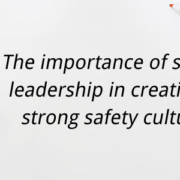How to Establish and Maintain a Positive Safety Culture
Establishing a Positive Safety Culture
Establishing a positive safety culture is essential for creating a safe and healthy work environment. And a strong safety culture can lead to reduced accidents and injuries, improved employee morale, and increased productivity. In this article, we will discuss the steps organisations can take to establish and maintain a positive safety culture.
1. Commitment from Leadership
Leadership commitment is crucial for establishing a positive safety culture. Leaders must demonstrate their commitment to safety by setting clear expectations, providing adequate resources, and leading by example. This commitment should be communicated to employees and reinforced through consistent actions and decisions. Implementing effective safety training programs, such as the IOSH Managing Safely course, further reinforces this commitment and empowers employees with the knowledge and skills to prioritise safety in their daily work. By investing in the development of their workforce through comprehensive safety training, organisations not only ensure compliance with regulations but also foster a culture of continuous improvement and vigilance towards safety.
2. Employee Involvement
Employees play a vital role in maintaining a positive safety culture. Encourage employee involvement in safety initiatives by soliciting their input, providing opportunities for them to participate in safety committees or teams, and recognising their contributions to improving safety performance.
3. Effective Communication
Clear and open communication is essential for fostering a positive safety culture. Establish channels for employees to report hazards, concerns, and suggestions for improvement. Ensure that employees receive regular updates on safety performance, new policies, and procedures, and any changes in regulations.
4. Comprehensive Safety Training
Providing employees with the necessary knowledge and skills to work safely is essential for maintaining a positive safety culture. Offer regular safety training that covers both general safety principles and job-specific hazards. Ensure that new employees receive adequate safety training during onboarding.
5. Regular Assessments and Audits
Conduct regular assessments and audits to evaluate the effectiveness of safety programs and identify areas for improvement. Use the results of these assessments to make data-driven decisions and prioritise safety initiatives.
6. Continuous Improvement
Maintaining a positive safety culture requires a commitment to continuous improvement. Encourage employees to identify and report hazards and near misses and use this information to proactively address potential issues. Regularly review and update safety policies, procedures, and training programs to ensure they remain relevant and effective.
7. Recognition and Reward
Recognise and reward employees for their contributions to safety performance. This could include acknowledging individual or team achievements, offering incentives for meeting safety goals, or providing opportunities for professional development.
The importance of Maintaining a Positive Safety Culture
Establishing and maintaining a positive safety culture is an ongoing process that requires commitment, communication, and continuous improvement. By involving employees, providing effective safety training, and regularly assessing safety performance, organisations can create a safe and healthy work environment that benefits both employees and the bottom line.










Leave a Reply
Want to join the discussion?Feel free to contribute!